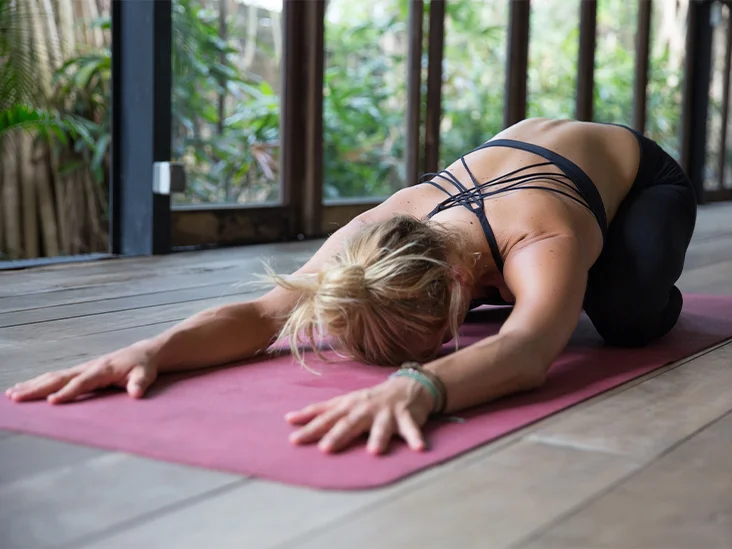7 Lower Back Stretches to Reduce Pain and Build Strength

Lower back pain often gets pushed to the side as you go about your day, but gentle exercises that strengthen and loosen your muscles can relieve it faster.
When you’re ready to do some stretches, be careful not to push too far past your comfort level. If you’re flection sensitive (leaning forward creates pain), or extension sensitive (arching backward creates pain), be extra cautious.
1. Child’s Pose
Child’s Pose (also known as prayer stretch) is a great lower back stretch that can also relieve stress and anxiety. It is especially helpful to practice before bedtime or in the morning, when the body and mind are more receptive to calming down.
Resting on your knees, torso supported by the floor, and arms extended in front of you, child’s pose is a meditative posture that stretches the back muscles, hips, chest, and shoulders. It also calms the nervous system and promotes a sense of well-being on and off the mat.
However, some people have a hard time getting into this posture, which may be related to tightness or joint mobility issues. If you experience pain in your groin or a stiffness in the hip flexors during this pose, try improving your flexibility by practicing deep hip flexion exercises and other yoga moves that increase your range of motion.
To ease the sacroiliac pain you might be feeling during child’s pose, use a blanket or pillow between your knees and lower legs to support your thighs and torso. This lessens compression in the knee joints, says Theresa Marko, DPT, owner of Marko Physical Therapy.
Also Read: WellHealthOrganic.com: Weight Loss in Monsoon – These 5 Monsoon Fruits Can Help You Lose Weight
2. Knee-to-chest stretch
The knee-to-chest stretch is a gentle and effective exercise that can help reduce lower back pain. It also helps to build strength in the hips and hamstrings.
It targets several muscles in the lower back and buttocks, including the erector spinae, latissimus dorsi, gluteus medius, gluteus minimus and thoracolumbar fascia. It’s recommended for people who have back pain from arthritis or disc problems.
To do this exercise, lie on your back with one leg bent and your other knee lifted off the floor. Clasp your hands around the knee of your raised leg, and gently pull it toward your chest. Hold this position for 15 to 30 seconds and then repeat on the other leg.
If you have tight hips and knees, make this stretch better by lengthening your tailbone down towards your feet as you bring your extended leg up. This will also engage your abdominal muscles and help to ground you, which can protect your spine.
This is a great exercise to do at the start of your day, before you begin any heavy activities. If you have a chronic back problem, or pain that worsens at night, it’s important to consult with your doctor before trying this or any other exercise program.
3. Piriformis stretch
The piriformis muscle sits deep in your buttocks and is an important part of your hip movement. It connects your upper thigh bone to your lower spine on each side of the pelvis and works with the two glute muscles to stabilize your hips.
However, if this muscle gets tight it can compress the sciatic nerve which can cause pain in your buttocks and legs. This is called piriformis syndrome.
There are a number of ways to reduce the pain caused by this condition. Some of them include stretches, massages, heat therapy and acupuncture.
You should also avoid certain positions that trigger the pain. These can include lying down on your stomach, sitting for long periods of time and bending forwards.
Another way to reduce the pain and build strength is by doing dynamic piriformis stretching. This type of stretching is more effective than static piriformis stretching because it develops stability and strength in the piriformis muscle as you stretch it.
You should do these stretches a few times per week and make sure to rest and recover properly after each stretch. This will help the body heal the microtears created by these stretches.
4. Seated spinal twist
Seated spinal twists are an excellent way to stretch the lower back and open the shoulders. They also help to strengthen and build muscle tone in the hips and glutes.
Start in an easy seated position. Bend your right knee and place your heel close to your body on the floor, and put your left elbow across the outside of your knee.
Hold this position for five breaths, then switch sides and repeat. This is a great pose to warm up and lengthen your spine before class or towards the end of your practice.
To increase the depth of this pose, sit up on a block or blanket so your sitting bones rest evenly on the floor and you can keep your rib cage long.
You can also try bringing your hands to your side and stretching them out toward the front of your body. Twisting this way will focus more of your energy on the torso and less on your neck.
To initiate the twist, roll your right shoulder back and twist from the back of the spine, feeling the movement originating in the spine and not in your neck. Then turn your head to the left and soften your gaze.
Also Read: Benefits of Watermelon for a Healthy Life
5. Pelvic tilt
If you are experiencing back pain or if your posture is hunched, you may have pelvic tilt. This can affect the sacroiliac joints, and it is a common cause of lower back pain.
Pelvic tilt can also lead to muscular imbalances and tension in your lumbar spine, buttocks, and hips. This can be especially problematic for people who sit a lot at work, or those who do strenuous exercises like running or lifting heavy objects.
The good news is that you can address pelvic tilt through targeted stretching and strengthening exercises, which will reverse your pelvic tilt and return it to neutral. To do this, we recommend foam rolling and performing targeted stretches to stretch the short muscles and strengthen the long ones.
Start by lying on your back with your knees bent and feet flat on the floor. Tilt your pelvis toward the rear of your body and pull one knee toward your chest with your hands, relaxing through your hips.
Once you’ve mastered the basic pelvic tilt, you can progress to a more advanced version that involves two knees tucked in toward your chest. This movement is called the pelvic tilt with double knee tuck, and it can be challenging as you’ll need to keep your low back firmly pressed into the ground while bracing your abs.
6. Cat-Cow
The Cat-Cow (also known as Bitilasana or Marjaryasana) is an excellent stretch to reduce back pain and build strength. It stretches your lower spine, hips, and core muscles to improve posture. It’s also a great warm-up stretch before yoga or any other workout.
In order to be safe, this movement is only possible if you follow a few rules: Keep your arms straight and your knees and hips in place. You’ll need to move your spine in two different directions to get the maximum benefit from this exercise: spinal flexion and spinal extension.
You can do this pose on your hands and knees or you can do it while sitting upright in a chair. The seated version is especially good for those with wrist or knee injuries.
This is a beginner-friendly exercise that can be done by most people. However, it’s important to keep the neck and shoulders relaxed when you perform this movement. If you force your head to drop down or if you crank your neck, you could cause injury.
Also Read: Understanding the Causes of White Hair and Natural Ways to Prevent it
7. Sphinx stretch
Sphinx pose is a gentle backbend that can reduce pain and build strength in your upper body. This beginner-friendly stretch stretches your chest, spine, and buttocks, making it a great way to prepare for deeper backbends like cobra pose.
Practicing Sphinx pose can also help to open up tight areas of the body, which can relieve low back pain. It’s also a good way to tone the gluteus muscles, which support the pelvis, hips, and spine.
In addition to helping to reduce back pain, Sphinx pose can also relieve stress and fatigue. This is because it helps to relax the body, which can be beneficial for people who have work-related stress.
Another benefit of practicing Sphinx stretch is that it can help to ease tension in your shoulders, which can contribute to neck pain. This is because it helps to keep your shoulders and triceps from hunching forward, which can cause tension in the shoulder blades.
To get started with this pose, lie down on your stomach with your feet slightly apart and your elbows under your shoulders. Then, raise your upper torso and head away from the floor. You can hold this position for 30 seconds to a minute.











